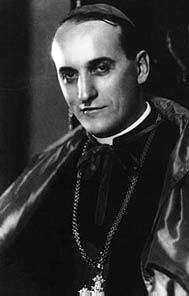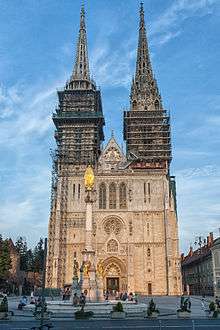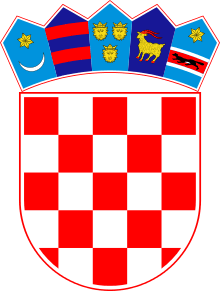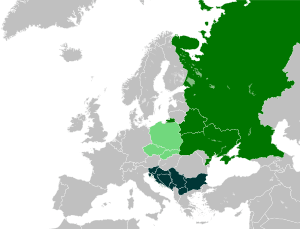Croats
Croats (/ˈkroʊæts, ˈkroʊɑːts/; Croatian: Hrvati, pronounced [xr̩ʋăːti]), also known as Croatians, are a nation and South Slavic ethnic group native to Croatia and Bosnia and Herzegovina. They are also a recognized minority in a number of neighboring countries, namely Austria, the Czech Republic, Germany, Hungary, Italy, Montenegro, Romania, Serbia, Slovakia, and Slovenia.
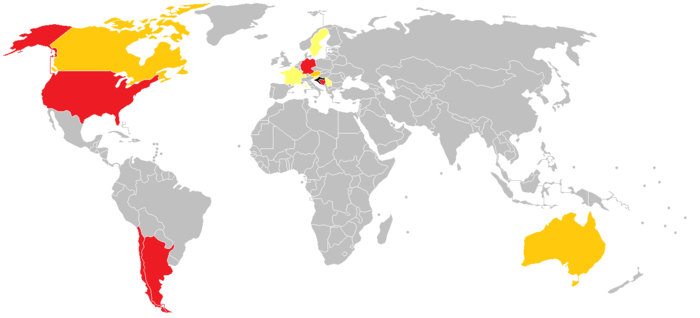 | |||||||||||||||||||||||||||||||||||
| Total population | |||||||||||||||||||||||||||||||||||
|---|---|---|---|---|---|---|---|---|---|---|---|---|---|---|---|---|---|---|---|---|---|---|---|---|---|---|---|---|---|---|---|---|---|---|---|
| c. 8 million[1] | |||||||||||||||||||||||||||||||||||
| Regions with significant populations | |||||||||||||||||||||||||||||||||||
3,874,321 (2011)[2] 544,780 (2013)[3] | |||||||||||||||||||||||||||||||||||
| 414,714 (2012)[4] – 1.2 million[5] | |||||||||||||||||||||||||||||||||||
| 441,000 (2016)[6][7] | |||||||||||||||||||||||||||||||||||
| 200,000[8] – 380,000[9] | |||||||||||||||||||||||||||||||||||
| 250,000[8] | |||||||||||||||||||||||||||||||||||
| 150,719 (2001)[10] | |||||||||||||||||||||||||||||||||||
| 133,965 (2016)[11] | |||||||||||||||||||||||||||||||||||
| 133,268 (2016)[12] | |||||||||||||||||||||||||||||||||||
| 60,000[13] | |||||||||||||||||||||||||||||||||||
| 57,900 (2011)[14] | |||||||||||||||||||||||||||||||||||
| 40,848 (2006)[15] | |||||||||||||||||||||||||||||||||||
| 40,000 (est.)[16] | |||||||||||||||||||||||||||||||||||
| 35,642[17] | |||||||||||||||||||||||||||||||||||
| 35,000 (est.)[18] | |||||||||||||||||||||||||||||||||||
| |||||||||||||||||||||||||||||||||||
| Europe | c. 5.3 million | ||||||||||||||||||||||||||||||||||
| North America | c. 530,000–2,500,000[b] | ||||||||||||||||||||||||||||||||||
| South America | c. 470,000–650,000 | ||||||||||||||||||||||||||||||||||
| Other | c. 140,000–250,000 | ||||||||||||||||||||||||||||||||||
| Languages | |||||||||||||||||||||||||||||||||||
| Croatian | |||||||||||||||||||||||||||||||||||
| Religion | |||||||||||||||||||||||||||||||||||
| Predominantly Roman Catholicism[34] | |||||||||||||||||||||||||||||||||||
| Related ethnic groups | |||||||||||||||||||||||||||||||||||
| Other South Slavs[35] | |||||||||||||||||||||||||||||||||||
a The total figure is merely an estimation; sum of all the referenced populations. b References:[36][37][38][39][40][41][42] | |||||||||||||||||||||||||||||||||||
Due to political, social and economic reasons, many Croats migrated to North and South America (Argentina, Chile, and Paraguay) as well as Australia and New Zealand, establishing a diaspora in the aftermath of World War II, with grassroots assistance from earlier communities and the Roman Catholic Church.[43][44]
Croats are mostly Roman Catholics. The Croatian language is official in Croatia, the European Union,[45] and Bosnia and Herzegovina.[46] Croatian is a recognised minority language within Croatian autochthonous communities and minorities in Montenegro, Austria (Burgenland), Italy (Molise), Romania (Carașova, Lupac) and Serbia (Vojvodina).
History
Formative period
"Dark Ages"
Evidence is rather scarce for the period between the 7th and 8th centuries, CE. Archaeological evidence shows population continuity in coastal Dalmatia and Istria. In contrast, much of the Dinaric hinterland appears to have been depopulated, as virtually all hilltop settlements, from Noricum to Dardania, were abandoned (only few appear destroyed) in the early 7th century. Although the dating of the earliest Slavic settlements is still disputed, there is a hiatus of almost a century. The origin, timing and nature of the Slavic migrations remain controversial, however, all available evidence points to the nearby Danubian and Carpathian regions.[47]
Croat ethnogenesis
The ethnonym "Croat" is first attested during the 9th century CE,[48] in the charter of Duke Trpimir; and indeed begins to be widely attested throughout central and eastern Europe during the 9th and 10th centuries.[49] Much uncertainty revolves around the exact circumstances of their appearance given the scarcity of literary sources during the 7th and 8th century "Dark Ages".
Traditionally, scholarship has placed the arrival of the White Croats from Great/White Croatia in the 7th century, primarily on the basis of the later Byzantine document De Administrando Imperio. As such, the arrival of the Croats was seen as a second wave of Slavic migrations, which took over Dalmatia from Avar hegemony. However, as early as the 1970s, scholars questioned the reliability of Porphyrogenitus' work, written as it was in the 10th century. Rather than being an accurate historical account, De Administrando Imperio more accurately reflects the political situation during the 10th century. It mainly served as Byzantine propaganda praising Emperor Heraclius for repopulating the Balkans (previously devastated by the Avars) with Croats, who were seen by the Byzantines as tributary peoples living on what had always been 'Roman land'.[50]
Scholars have hypothesized the name Croat (Hrvat) may be Iranian, thus suggesting that the Croatians were possibly a Sarmatian tribe from the Pontic region who were part of a larger movement at the same time that the Slavs were moving toward the Adriatic. The major basis for this connection was the perceived similarity between Hrvat and inscriptions from the Tanais dated to the 2nd and 3rd centuries CE, mentioning the name Khoro(u)athos. Similar arguments have been made for an alleged Gothic-Croat link. Whilst there is indeed possible evidence of population continuity between Gothic and Croatian times in parts of Dalmatia, the idea of a Gothic origin of Croats was more rooted in 20th century Ustaše political aspirations than historical reality.[51]
Contemporary scholarship views the rise of "Croats" as an autochthonous, Dalmatian response to the demise of the Avar khanate and the encroachment of Frankish and Byzantine Empires into northern Dalmatia.[52] They appear to have been based around Nin and Klis, down to the Cetina and south of Liburnia. Here, concentrations of the "Old Croat culture" abound, marked by some very wealthy warrior burials dating to the 9th century CE.[53]
Other polities in Dalmatia and Pannonia
Other, distinct polities also existed near the Croat duchy. These included the Guduscans (based in Liburnia), the Narentines (around the Cetina and Neretva) and the Sorabi (Serbs) who ruled some other eastern parts of ex-Roman "Dalmatia".[54] Also prominent in the territory of future Croatia was the polity of Prince Liutevid, who ruled the territories between the Drava and Sava rivers ("Pannonia Inferior"), centred from his fort at Sisak. Although Duke Liutevid and his people are commonly seen as a "Pannonian Croats", he is, due to the lack of "evidence that they had a sense of Croat identity" referred to as dux Pannoniae Inferioris, or simply a Slav, by contemporary sources.[55][56] However, soon, the Croats became the dominant local power in northern Dalmatia, absorbing Liburnia and expanding their name by conquest and prestige. In the south, while having periods of independence, the Naretines also "merged" with Croats later under control of Croatian Kings.[57] With such expansion, Croatia soon became the dominant power and absorbed other polities between Frankish, Bulgarian and Byzantine empire. Although the Chronicle of the Priest of Duklja has been dismissed as an unreliable record, the mentioned "Red Croatia" suggests that Croatian clans and families might have settled as far south as Duklja/Zeta[58] and city of Drač in today's Albania.[59]
Early medieval age
| Part of a series on |
| Croats |
|---|
 |
|
Subgroups |
The lands which constitute modern Croatia fell under three major geographic-politic zones during the Middle Ages, which were influenced by powerful neighbour Empires – notably the Byzantines, the Avars and later Magyars, Franks and Bulgars. Each vied for control of the Northwest Balkan regions. Nevertheless, two independent Slavic dukedoms emerged sometime during the 9th century: the Croat Duchy and Principality of Lower Pannonia.
Pannonian Principality ("Savia")
Having been under Avar control, lower Pannonia became a march of the Carolingian Empire around 800. Aided by Vojnomir in 796, the first named Slavic Duke of Pannonia, the Franks wrested control of the region from the Avars before totally destroying the Avar realm in 803. After the death of Charlemagne in 814, Frankish influence decreased on the region, allowing Prince Ljudevit Posavski to raise a rebellion in 819.[60] The Frankish margraves sent armies in 820, 821 and 822, but each time they failed to crush the rebels.[60] Aided by Borna the Guduscan, the Franks eventually defeated Ljudevit, who withdrew his forces to the Serbs and conquered them, according to the Frankish Annals.
For much of the subsequent period, Savia was probably directly ruled by the Carinthian Duke Arnulf, the future East Frankish King and Emperor. However, Frankish control was far from smooth. The Royal Frankish Annals mention several Bulgar raids, driving up the Sava and Drava rivers, as a result of a border dispute with the Franks, from 827. By a peace treaty in 845, the Franks were confirmed as rulers over Slavonia, whilst Srijem remained under Bulgarian clientage. Later, the expanding power of Great Moravia also threatened Frankish control of the region. In an effort to halt their influence, the Franks sought alliance with the Magyars, and elevated the local Slavic leader Braslav in 892, as a more independent Duke over lower Pannonia.
In 896, his rule stretched from Vienna and Budapest to the southern Croat dutchies, and included almost the whole of ex-Roman Pannonian provinces (whole 4). He probably died c. 900 fighting against his former allies, the Magyars.[60] The subsequent history of Savia again becomes mirky, and historians are not sure who controlled Savia during much of the 10th century. However, it is likely that the ruler Tomislav, the first crowned King, was able to exert much control over Savia and adjacent areas during his reign. It is indeed at this time that sources first refer to a "Pannonian Croatia", appearing in the 10th century Byzantine work De Administrando Imperio.[60]
Dalmatian Croats
In the meantime, the Dalmatian Croats were recorded to have been subject to the Kingdom of Italy under Lothair I, since 828. The Croatian Prince Mislav (835–845) built up a formidable navy, and in 839 signed a peace treaty with Pietro Tradonico, doge of Venice. The Venetians soon proceeded to battle with the independent Slavic pirates of the Pagania region, but failed to defeat them. The Bulgarian king Boris I (called by the Byzantine Empire Archont of Bulgaria after he made Christianity the official religion of Bulgaria) also waged a lengthy war against the Dalmatian Croats, trying to expand his state to the Adriatic.
The Croatian Prince Trpimir I (845–864) succeeded Mislav. In 854, there was a great battle between Trpimir's forces and the Bulgars. Neither side emerged victorious, and the outcome was the exchange of gifts and the establishment of peace. Trpimir I managed to consolidate power over Dalmatia and much of the inland regions towards Pannonia, while instituting counties as a way of controlling his subordinates (an idea he picked up from the Franks). The first known written mention of the Croats, dates from 4 March 852, in statute by Trpimir. Trpimir is remembered as the initiator of the Trpimirović dynasty, that ruled in Croatia, with interruptions, from 845 until 1091. After his death, an uprising was raised by a powerful nobleman from Knin – Domagoj, and his son Zdeslav was exiled with his brothers, Petar and Muncimir to Constantinople.[61]
Facing a number of naval threats by Saracens and Byzantine Empire, the Croatian Prince Domagoj (864–876) built up the Croatian navy again and helped the coalition of emperor Louis II and the Byzantine to conquer Bari in 871. During Domagoj's reign piracy was a common practice, and he forced the Venetians to start paying tribute for sailing near the eastern Adriatic coast. After Domagoj's death, Venetian chronicles named him "The worst duke of Slavs", while Pope John VIII referred to Domagoj in letters as "Famous duke". Domagoj's son, of unknown name, ruled shortly between 876 and 878 with his brothers. They continued the rebellion, attacked the western Istrian towns in 876, but were subsequently defeated by the Venetian navy. Their ground forces defeated the Pannonian duke Kocelj (861–874) who was suzerain to the Franks, and thereby shed the Frankish vassal status. Wars of Domagoj and his son liberated Dalmatian Croats from supreme Franks rule. Zdeslav deposed him in 878 with the help of the Byzantines. He acknowledged the supreme rule of Byzantine Emperor Basil I. In 879, the Pope ask for help from prince Zdeslav for an armed escort for his delegates across southern Dalmatia and Zahumlje,[62] but on early May 879, Zdeslav was killed near Knin in an uprising led by Branimir, a relative of Domagoj, instigated by the Roman Pope fearing Byzantine power.
Branimir's (879–892) own actions were approved from the Holy See to bring the Croats further away from the influence of Byzantium and closer to Rome. Duke Branimir wrote to Pope John VIII affirming this split from Byzantine and commitment to the Roman Papacy. During the solemn divine service in St. Peter's church in Rome in 879, Pope gave his blessing to the duke and the whole Croatian people, about which he informed Branimir in his letters, in which Branimir was recognized as the Duke of the Croats (Dux Chroatorum).[63] During his reign, Croatia retained its sovereignty from both Holy Roman imperial and Byzantine rule, and became a fully recognized state.[64][65] After Branimir's death, Prince Muncimir (892–910), Zdeslav's brother, took control of Dalmatia and ruled it independently of both Rome and Byzantium as divino munere Croatorum dux (with God's help, duke of Croats). In Dalmatia, duke Tomislav (910–928) succeeded Muncimir. Tomislav successfully repelled Magyar mounted invasions of the Arpads, expelled them over the Sava River, and united (western) Pannonian and Dalmatian Croats into one state.[66][67][68]
Kingdom of Croatia (925–1102)
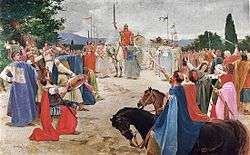
Tomislav (910–928) became king of Croatia by 925. The chief piece of evidence that Tomislav was crowned king comes in the form of a letter dated 925, surviving only in 16th-century copies, from Pope John X calling Tomislav rex Chroatorum. According to De Administrando Imperio, Tomislav's army and navy could have consisted approximately 100,000 infantry units, 60,000 cavaliers, and 80 larger (sagina) and 100 smaller warships (condura), but generally isn't taken as credible.[69] According to the palaeographic analysis of the original manuscript of De Administrando Imperio, the estimation of the number of inhabitants in medieval Croatia between 440 and 880 thousand people, and military numbers of Franks and Byzantines - the Croatian military force was most probably composed of 20,000-100,000 infantrymen, and 3,000-24,000 horsemen organized in 60 allagions.[70][71] Croatian Kingdom as an ally of Byzantine Empire was in conflict with the rising Bulgarian Empire ruled by Tsar Simeon I. In 923, due to a deal of Pope John X and a Patriarch of Constantinopole, the sovereignty of Byzantine coastal cities in Dalmatia came under Tomislav's Governancy. The war escalated on 27 May 927, in the battle of the Bosnian Highlands, after Serbs were conquered and some fled to the Croatian Kingdom. There Croats under leadership of their king Tomislav completely defeated the Bulgarian army led by military commander Alogobotur, and stopped Simeon's extension westwards.[72][73][74] The central town in the Duvno field was named Tomislavgrad ("Tomislav's town") in his honour in the 20th century.
Tomislav was succeeded by Trpimir II (928–935), and Krešimir I (935–945), this period, on the whole, however, is obscure. Miroslav (945–949) was killed by his ban Pribina during an internal power struggle, losing part of islands and coastal cities. Krešimir II (949–969) kept particularly good relations with the Dalmatian cities, while his son Stjepan Držislav (969–997) established better relations with the Byzantine Empire and received a formal authority over Dalmatian cities. His three sons, Svetoslav (997–1000), Krešimir III (1000–1030) and Gojslav (1000–1020), opened a violent contest for the throne, weakening the state and further losing control. Krešimir III and his brother Gojslav co-ruled from 1000 until 1020, and attempted to restore control over lost Dalmatian cities now under Venetian control. Krešimir was succeeded by his son Stjepan I (1030–1058), who tried to reinforce the alliance with the Byzantines when he sent a segment of his naval fleet in war against the Arabs in 1032, in favour for their tolerance about conquering Zadar another Byzantine ally, from Venice. He did conquer it, but the circumstances changed later and lost it.
Krešimir IV (1058–1074) managed to get the Byzantine Empire to confirm him as the supreme ruler of the Dalmatian cities.[75] Croatia under Krešimir IV was composed of twelve counties and was slightly larger than in Tomislav's time, and included the closest southern Dalmatian duchy of Pagania. From the outset, he continued the policies of his father, but was immediately commanded by Pope Nicholas II first in 1059 and then in 1060 to reform the Croatian church in accordance with the Roman rite. This was especially significant to the papacy in the aftermath of the Great Schism of 1054.
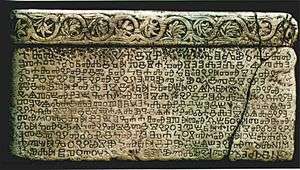
He was succeeded by Dmitar Zvonimir, who was of the Svetoslavić branch of the House of Trpimirović, and a Ban of Slavonia (1064–1075). He was crowned on 8 October 1076[76][77] at Solin in the Basilica of Saint Peter and Moses (known today as Hollow Church) by a representative of Pope Gregory VII.[78][79]
He was in conflict with dukes of Istria, while historical records Annales Carinthiæ and Chronica Hungarorum note he invaded Carinthia to aid Hungary in war during 1079/83, but this is disputed. Unlike Petar Krešimir IV, he was also an ally of the Normans, with whom he joined in wars against Byzantium. He married in 1063 Helen of Hungary, the daughter of King Bela I of the Hungarian Árpád dynasty, and the sister of the future King Ladislaus I. As King Zvonimir died in 1089 in unknown circumstances, with no direct heir to succeed him, Stjepan II (r. 1089–1091) last of the main Trpimirović line came to the throne at an old age and reigned for two years.
After his death civil war and unrest broke out shortly afterward as northern nobles decided Ladislaus I for the Croatian King. In 1093, southern nobles elected a new ruler, King Petar Svačić (r. 1093–1097), who managed to unify the Kingdom around his capital of Knin. His army resisted repelling Hungarian assaults, and restored Croatian rule up to the river Sava. He reassembled his forces in Croatia and advanced on Gvozd Mountain, where he met the main Hungarian army led by King Coloman I of Hungary. In 1097, in the Battle of Gvozd Mountain, the last native king Peter was killed and the Croats were decisively defeated (because of this, the mountain was this time renamed to Petrova Gora, "Peter's Mountain"). In 1102, Coloman returned to the Kingdom of Croatia in force, and negotiated with the Croatian feudal lords resulting in joining of Hungarian and Croatian crowns (with the crown of Dalmatia held separate from that of Croatia).
Personal union with Hungary (1102–1918)
.jpg)
In the union with Hungary, institutions of separate Croatian statehood were maintained through the Sabor (an assembly of Croatian nobles) and the ban (viceroy). In addition, the Croatian nobles retained their lands and titles.[80] Coloman retained the institution of the Sabor and relieved the Croatians of taxes on their land. Coloman's successors continued to crown themselves as Kings of Croatia separately in Biograd na Moru.[81] The Hungarian king also introduced a variant of the feudal system. Large fiefs were granted to individuals who would defend them against outside incursions thereby creating a system for the defence of the entire state. However, by enabling the nobility to seize more economic and military power, the kingdom itself lost influence to the powerful noble families. In Croatia the Šubić were one of the oldest Croatian noble families and would become particularly influential and important, ruling the area between Zrmanja and the Krka rivers. The local noble family from Krk island (who later took the surname Frankopan) is often considered the second most important medieval family, as ruled over northern Adriatic and is responsible for the adoption of one of oldest European statutes, Law codex of Vinodol (1288). Both families gave many native bans of Croatia. Other powerful families were Nelipić from Dalmatian Zagora (14th–15th centuries); Kačić who ruled over Pagania and were famous for piracy and wars against Venice (12th–13th centuries); Kurjaković family, a branch of the old Croatian noble family Gusić from Krbava (14th–16th centuries); Babonići who ruled from western Kupa to eastern Vrbas and Bosna rivers, and were bans of Slavonia (13th–14th centuries); Iločki family who ruled over Slavonian stronghold-cities, and in the 15th century rose to power. During this period, the Knights Templar and the Knights Hospitaller also acquired considerable property and assets in Croatia.
In the second half of the 13th century, during the Árpád and Anjou dynasty struggle, the Šubić family became hugely powerful under Paul I Šubić of Bribir, who was the longest Croatian Ban (1274–1312), conquering Bosnia and declaring himself "Lord of all of Bosnia" (1299–1312). He appointed his brother Mladen I Šubić as Ban of Bosnia (1299–1304), and helped Charles I from House of Anjou to be the King of Hungary. After his death in 1312, his son Mladen II Šubić was the Ban of Bosnia (1304–1322) and Ban of Croatia (1312–1322). The kings from House of Anjou intended to strengthen the kingdom by uniting their power and control, but to do so they had to diminish the power of the higher nobility. Charles I had already tried to crash the aristocratic privileges, intention finished by his son Louis the Great (1342–1382), relying on the lower nobility and towns. Both kings ruled without the Parliament, and inner nobility struggles only helped them in their intentions. This led to Mladen's defeat at the battle of Bliska in 1322 by a coalition of several Croatian noblemen and Dalmatian coastal towns with support of the King himself, in exchange of Šubić's castle of Ostrovica for Zrin Castle in Central Croatia (thus this branch was named Zrinski) in 1347. Eventually, the Babonić and Nelipić families also succumbed to the king's offensive against nobility, but with the increasing process of power centralization, Louis managed to force Venice by the Treaty of Zadar in 1358 to give up their possessions in Dalmatia. When King Louis died without successor, the question of succession remained open. The kingdom once again entered the time of internal unrest. Besides King Louis's daughter Mary, Charles III of Naples was the closest king male relative with claims to the throne. In February 1386, two months after his coronation, he was assassinated by order of the queen Elizabeth of Bosnia. His supporters, bans John of Palisna, John Horvat and Stjepan Lacković planned a rebellion, and managed to capture and imprison Elizabeth and Mary. By orders of John of Palisna, Elizabeth was strangled. In retaliation, Magyars crowned Mary's husband Sigismund of Luxembourg.
King Sigismund's army was catastrophically defeated at the Battle of Nicopolis (1396) as the Ottoman invasion was getting closer to the borders of the Hungarian-Croatian kingdom. Without news about the king after the battle, the then ruling Croatian ban Stjepan Lacković and nobles invited Charles III's son Ladislaus of Naples to be the new king. This resulted with Bloody Sabor of Križevci in 1397, lose of interest for the crown by Ladislaus and selling of Dalmatia to Venice in 1403, and spreading of Croatian name to the north, while of Slavonia to the east. The dynastic struggle didn't finish, and with the Ottoman invasion on Bosnia started the first short raids in Croatian territory, defended only by local nobles.
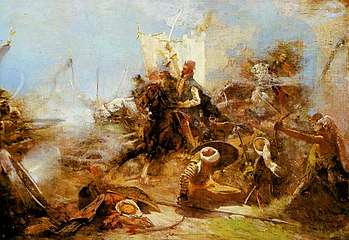
As the Turkish incursion into Europe started, Croatia once again became a border area between two major forces in the Balkans. Croatian military troops fought in many battles under command of Italian Franciscan priest fra John Capistrano, the Hungarian Generalissimo John Hunyadi, and Hungarian King Matthias Corvinus, like in the Hunyadi's long campaign (1443–1444), battle of Varna (1444), second battle of Kosovo (1448), and contributed to the Christian victories over the Ottomans in the siege of Belgrade (1456) and Siege of Jajce (1463). At the time they suffered a major defeat in the battle of Krbava field (Lika, Croatia) in 1493 and gradually lost increasing amounts of territory to the Ottoman Empire. Pope Leo X called Croatia the forefront of Christianity (Antemurale Christianitatis) in 1519, given that several Croatian soldiers made significant contributions to the struggle against the Ottoman Turks. Among them there were ban Petar Berislavić who won a victory at Dubica on the Una river in 1513, the captain of Senj and prince of Klis Petar Kružić, who defended the Klis Fortress for almost 25 years, captain Nikola Jurišić who deterred by a magnitude larger Turkish force on their way to Vienna in 1532, or ban Nikola Šubić Zrinski who helped save Pest from occupation in 1542 and fought in the Battle of Szigetvar in 1566. During the Ottoman conquest tens of thousands of Croats were taken in Turkey, where they became slaves.
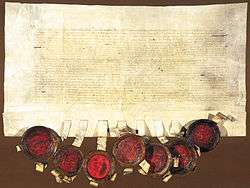
The Battle of Mohács (1526) and the death of King Louis II ended the Hungarian-Croatian union. In 1526, the Hungarian parliament elected two separate kings János Szapolyai and Ferdinand I Habsburg, but the choice of the Croatian sabor at Cetin prevailed on the side of Ferdinand I, as they elected him as the new king of Croatia on 1 January 1527,[82] uniting both lands under Habsburg rule. In return they were promised the historic rights, freedoms, laws and defence of Croatian Kingdom.
However, the Hungarian-Croatian Kingdom was not enough well prepared and organized and the Ottoman Empire expanded further in the 16th century to include most of Slavonia, western Bosnia and Lika. For the sake of stopping the Ottoman conquering and possible assault on the capital of Vienna, the large areas of Croatia and Slavonia (even Hungary and Romania) bordering the Ottoman Empire were organized as a Military Frontier which was ruled directly from Vienna military headquarters.[83] The invasion caused migration of Croats, and the area which became deserted was subsequently settled by Serbs, Vlachs, Germans and others. The negative effects of feudalism escalated in 1573 when the peasants in northern Croatia and Slovenia rebelled against their feudal lords due to various injustices. After the fall of Bihać fort in 1592, only small areas of Croatia remained unrecovered. The remaining 16,800 square kilometres (6,487 sq mi) were referred to as the reliquiae reliquiarum of the once great Croatian kingdom.[84]
Croats stopped the Ottoman advance in Croatia at the battle of Sisak in 1593, 100 years after the defeat at Krbava field, and the short Long Turkish War ended with the Peace of Zsitvatorok in 1606, after which Croatian classes tried unsuccessfully to have their territory on the Military Frontier restored to rule by the Croatian Ban, managing only to restore a small area of lost territory but failed to regain large parts of Croatian Kingdom (present-day western Bosnia and Herzegovina), as the present-day border between the two countries is a remnant of this outcome.
Croatian national revival (1593–1918)
In the first half of the 17th century, Croats fought in the Thirty Years' War on the side of Holy Roman Empire, mostly as light cavalry under command of imperial generalissimo Albrecht von Wallenstein. Croatian Ban, Juraj V Zrinski, also fought in the war, but died in a military camp near Bratislava, Slovakia, as he was poisoned by von Wallenstein after a verbal duel. His son, future ban and captain-general of Croatia, Nikola Zrinski, participated during the closing stages of the war.
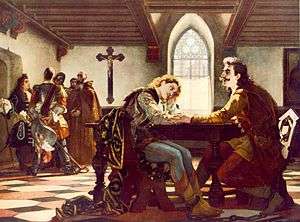
In 1664, the Austrian imperial army was victorious against the Turks, but Emperor Leopold failed to capitalize on the success when he signed the Peace of Vasvár in which Croatia and Hungary were prevented from regaining territory lost to the Ottoman Empire. This caused unrest among the Croatian and Hungarian nobility which plotted against the emperor. Nikola Zrinski participated in launching the conspiracy which later became to be known as the Magnate conspiracy, but he soon died, and the rebellion was continued by his brother, Croatian ban Petar Zrinski, Fran Krsto Frankopan and Ferenc Wesselényi. Petar Zrinski, along the conspirators, went on a wide secret diplomatic negotiations with a number of nations, including Louis XIV of France, the Polish–Lithuanian Commonwealth, Sweden, the Republic of Venice and even the Ottoman Empire, to free Croatia from the Habsburg sovereignty.
Imperial spies uncovered the conspiracy and on 30 April 1671 executed four esteemed Croatian and Hungarian noblemen involved in it, including Zrinski and Frankopan in Wiener Neustadt. The large estates of two most powerful Croatian noble houses were confiscated and their families relocated, soon after extinguished. Between 1670 and the revolution of 1848, there would be only 2 bans of Croatian nationality. The period from 1670 to the Croatian cultural revival in the 19th century was Croatia's political dark age. Meanwhile, with the victories over Turks, Habsburgs all the more insistent they spent centralization and germanization, new regained lands in liberated Slavonia started giving to foreign families as feudal goods, at the expense of domestic element. Because of this the Croatian Sabor was losing its significance, and the nobility less attended it, yet went only to the one in Hungary.
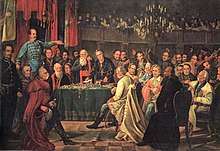
In the 18th century, Croatia was one of the crown lands that supported Emperor Charles's Pragmatic Sanction of 1713 and supported Empress Maria Theresa in the War of the Austrian Succession of 1741–48. Subsequently, the empress made significant contributions to Croatian matters, by making several changes in the feudal and tax system, administrative control of the Military Frontier, in 1745 administratively united Slavonia with Croatia and in 1767 organized Croatian royal council with the ban on head, however, she ignored and eventually disbanded it in 1779, and Croatia was relegated to just one seat in the governing council of Hungary, held by the ban of Croatia. To fight the Austrian centralization and absolutism, Croats passed their rights to the united government in Hungary, thus to together resist the intentions from Vienna. But the connection with Hungary soon adversely affected the position of Croats, because Magyars in the spring of their nationalism tried to Magyarize Croats, and make Croatia a part of a united Hungary. Because of this pretensions, the constant struggles between Croats and Magyars emerged, and lasted until 1918. Croats were fighting in unfavorable conditions, against both Vienna and Budapest, while divided on Banska Hrvatska, Dalmatia and Military Frontier. In such a time, with the fall of the Venetian Republic in 1797, its possessions in eastern Adriatic mostly came under the authority of France which passed its rights to Austria the same year. Eight years later they were restored to France as the Illyrian Provinces, but won back to the Austrian crown 1815. Though now part of the same empire, Dalmatia and Istria were part of Cisleithania while Croatia and Slavonia were in Hungarian part of the Monarchy.
.jpg)
In the 19th century Croatian romantic nationalism emerged to counteract the non-violent but apparent Germanization and Magyarization. The Croatian national revival began in the 1830s with the Illyrian movement. The movement attracted a number of influential figures and produced some important advances in the Croatian language and culture. The champion of the Illyrian movement was Ljudevit Gaj who also reformed and standardized the Croatian literary language. The official language in Croatia had been Latin until 1847, when it became Croatian. The movement relied on a South Slavic and Panslavistic conception, and its national, political and social ideas were advanced at the time.
By the 1840s, the movement had moved from cultural goals to resisting Hungarian political demands. By the royal order of 11 January 1843, originating from the chancellor Metternich, the use of the Illyrian name and insignia in public was forbidden. This deterred the movement's progress but it couldn't stop the changes in the society that had already started. On 25 March 1848, was conducted a political petition "Zahtijevanja naroda", which program included thirty national, social and liberal principles, like Croatian national independence, annexation of Dalmatia and Military Frontier, independence from Hungary as far as finance, language, education, freedom of speech and writing, religion, nullification of serfdom etc. In the revolutions of 1848 in the Austrian Empire, the Croatian Ban Jelačić cooperated with the Austrians in quenching the Hungarian Revolution of 1848 by leading a military campaign into Hungary, successful until the Battle of Pákozd.
Croatia was later subject to Hungarian hegemony under ban Levin Rauch when the Empire was transformed into a dual monarchy of Austria-Hungary in 1867. Nevertheless, Ban Jelačić had succeeded in the abolition of serfdom in Croatia, which eventually brought about massive changes in society: the power of the major landowners was reduced and arable land became increasingly subdivided, to the extent of risking famine. Many Croatians began emigrating to the New World countries in this period, a trend that would continue over the next century, creating a large Croatian diaspora.
Modern history (1918–present)
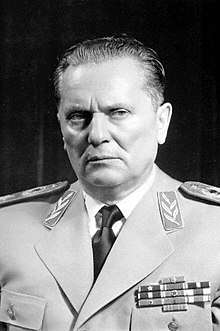
After the First World War and dissolution of Austria-Hungary, most Croats were united within the Kingdom of Serbs, Croats and Slovenes, created by unification of the short-lived State of SHS with the Kingdom of Serbia. Croats became one of the constituent nations of the new kingdom. The state was transformed into the Kingdom of Yugoslavia in 1929 and the Croats were united in the new nation with their neighbors – the South Slavs-Yugoslavs.
In 1939, the Croats received a high degree of autonomy when the Banovina of Croatia was created, which united almost all ethnic Croatian territories within the Kingdom. In the Second World War, the Axis forces created the Independent State of Croatia led by the Ustaše movement which sought to create an ethnically pure Croatian state on the territory corresponding to present-day countries of Croatia and Bosnia and Herzegovina. Post-WWII Yugoslavia became a federation consisting of 6 republics, and Croats became one of two constituent peoples of two – Croatia and Bosnia and Herzegovina. Croats in the Serbian autonomous province of Vojvodina are one of six main ethnic groups composing this region.[85]
Following the democratization of society, accompanied with ethnic tensions that emerged ten years after the death of Josip Broz Tito, the Republic of Croatia declared independence, which was followed by war. In the first years of the war, over 200,000 Croats were displaced from their homes as a result of the military actions. In the peak of the fighting, around 550,000 ethnic Croats were displaced altogether during the Yugoslav wars.
Post-war government's policy of easing the immigration of ethnic Croats from abroad encouraged a number of Croatian descendants to return to Croatia. The influx was increased by the arrival of Croatian refugees from Bosnia and Herzegovina. After the war's end in 1995, most Croatian refugees returned to their previous homes, while some (mostly Croat refugees from Bosnia and Herzegovina and Janjevci from Kosovo) moved into the formerly-held Serbian housing.
Genetics
Genetically, on the Y chromosome line, a majority (75%) of male Croats from Croatia belongs to haplogroups I (38%-43%), R1a (22%-25%) and R1b (8%-9%), while a minority (25%) mostly belongs to haplogroup E (10%), and others to haplogroups J (7%-10%), G (2%-4%), H (0.3-1.8%), and N (<1%).[86][87] The distribution, variance and frequency of the I and R1a subclades (>65%) among Croats is related to the medieval Slavic expansion, most probably from the territory of present day Ukraine and Southeastern Poland.[88][89][90][91] Genetically, on the maternal X chromosome line, a majority (>65%) of female Croats from Croatia (mainland and coast) belong to three of the eleven major European mtDNA haplogroups - H (45%), U (17.8-20.8%), J (3-11%), while a large minority (>35%) belongs to many other smaller haplogroups.[92] Based on autosomal IBD survey the speakers of Serbo-Croatian language share a very high number of common ancestors dated to the migration period approximately 1,500 years ago with Poland and Romania-Bulgaria clusters among others in Eastern Europe. It was caused by the Slavic expansion, a small population which expanded into vast regions of "low population density beginning in the sixth century".[93]
The region of modern-day Croatia may have served as a refugium for the northern populations during the Last Glacial Maximum (LGM).[94] The eastern Adriatic coast was much further south.[95] The northern and the western parts of that sea were steppes and plains, while the modern Croatian islands (rich in Paleolithic archeological sites) were hills and mountains.[95][94] The region had a specific role in the structuring of European, and particularly among Slavic, paternal genetic heritage, characterized by the predominance of R1a and I, and scarcity of E lineages.[96] Genetical results can not be used as the evidence for a specific ethnic component, but they indicate the main role of the Slavs in the Croatian ethnogenesis.[97]
Language
Croats speak Croatian, a South Slavic lect of the Western South Slavic subgroup. (Standard) Croatian is considered a normative variety of Serbo-Croatian,[98][99][100] and is mutually intelligible with the other three national standards, Serbian, Bosnian, and Montenegrin (see Comparison of standard Bosnian, Croatian, Montenegrin and Serbian) which are all based on the Shtokavian dialect.
Besides Shtokavian, Croats from the Adriatic coastline speak the Chakavian dialect, while Croats from the continental northwestern part of Croatia speak the Kajkavian dialect. Vernacular texts in the Chakavian dialect first appeared in the 13th century, and Shtokavian texts appeared a century later. Standardization began in the period sometimes called "Baroque Slavism" in the first half of the 17th century,[101] while some authors date it back to the end of the 15th century.[102] The modern Neo-Shtokavian standard that appeared in the mid 18th century was the first unified Croatian literary language.[103] Croatian is written in Gaj's Latin alphabet.[104]
The beginning of the Croatian written language can be traced to the 9th century, when Old Church Slavonic was adopted as the language of the Divine liturgy of St. John Chrysostom and the Divine Liturgy of Saint Basil. This language was gradually adapted to non-liturgical purposes and became known as the Croatian version of Old Slavonic. The two variants of the language, liturgical and non-liturgical, continued to be a part of the Glagolitic service as late as the middle of the 19th century. The earliest known Croatian Church Slavonic Glagolitic are Vienna Folios from the late 11th/early 12th century.[105] Until the end of the 11th century Croatian medieval texts were written in three scripts: Latin, Glagolitic, and Croatian Cyrillic (bosančica/bosanica),[106] and also in three languages: Croatian, Latin and Old Slavonic. The latter developed into what is referred to as the Croatian variant of Church Slavonic between the 12th and 16th centuries.
The most important early monument of Croatian literacy is the Baška tablet from the late 11th century.[107] It is a large stone tablet found in the small Church of St. Lucy, Jurandvor on the Croatian island of Krk which contains text written mostly in Chakavian, today a dialect of Croatian, and in Shtokavian angular Glagolitic script. It mentions Zvonimir, the king of Croatia at the time. However, the luxurious and ornate representative texts of Croatian Church Slavonic belong to the later era, when they coexisted with the Croatian vernacular literature. The most notable are the "Missal of Duke Novak" from the Lika region in northwestern Croatia (1368), "Evangel from Reims" (1395, named after the town of its final destination), Hrvoje's Missal from Bosnia and Split in Dalmatia (1404).[108] and the first printed book in Croatian language, the Glagolitic Missale Romanum Glagolitice (1483).[105]
During the 13th century Croatian vernacular texts began to appear, the most important among them being the "Istrian Land Survey" of 1275 and the "Vinodol Codex" of 1288, both written in the Chakavian dialect.[109][110]
The Shtokavian dialect literature, based almost exclusively on Chakavian original texts of religious provenance (missals, breviaries, prayer books) appeared almost a century later. The most important purely Shtokavian dialect vernacular text is the Vatican Croatian Prayer Book (ca. 1400).[111]
Both the language used in legal texts and that used in Glagolitic literature gradually came under the influence of the vernacular, which considerably affected its phonological, morphological and lexical systems. From the 14th and the 15th centuries, both secular and religious songs at church festivals were composed in the vernacular.
Religion
Croats are predominantly Roman Catholic, and before Christianity they adhered to Slavic paganism. The earliest record of contact between the Pope and the Croats dates from a mid-7th century entry in the Liber Pontificalis. Pope John IV (John the Dalmatian, 640–642) sent an abbot named Martin to Dalmatia and Istria in order to pay ransom for some prisoners and for the remains of old Christian martyrs. This abbot is recorded to have travelled through Dalmatia with the help of the Croatian leaders, and he established the foundation for the future relations between the Pope and the Croats.
The beginnings of the Christianization are also disputed in the historical texts: the Byzantine texts talk of duke Porin who started this at the incentive of emperor Heraclius (610–641), then of Duke Porga who mainly Christianized his people after the influence of missionaries from Rome, while the national tradition recalls Christianization during the rule of Dalmatian Duke Borna (810–821). It is possible that these are all renditions of the same ruler's name. The earliest known Croatian autographs from the 8th century are found in the Latin Gospel of Cividale.
Croats were never obliged to use Latin—rather, they held masses in their own language and used the Glagolitic alphabet.[112] In 1886 it arrived to the Principality of Montenegro, followed by the Kingdom of Serbia in 1914, and the Republic of Czechoslovakia in 1920, but only for feast days of the main patron saints. The 1935 concordat with the Kingdom of Yugoslavia anticipated the introduction of the Church Slavonic for all Croatian regions and throughout the entire state.[113]
This was officially sanctioned in 1248 by Pope Innocent IV, and only later did the Latin alphabet prevail. The Latin Rite prevailed over the Byzantine Rite rather early due to numerous interventions from the Holy See. There were numerous Roman Catholic synods held in Dalmatia in the 11th century, particularly after the East-West Schism of 1054, during the course of which the use of the Latin rite was run roughshod over the Divine Liturgy of St. John Chrysostom and the Divine Liturgy of St. Basil.
Culture
Tradition
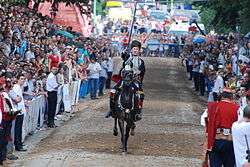
The area settled by Croats has a large diversity of historical and cultural influences, as well as diversity of terrain and geography. The coastland areas of Dalmatia and Istria were subject to Roman Empire, Venetian and Italian rule; central regions like Lika and western Herzegovina were a scene of battlefield against the Ottoman Empire, and have strong epic traditions. In the northern plains, Austro-Hungarian rule has left its marks. The most distinctive features of Croatian folklore include klapa ensembles of Dalmatia, tamburitza orchestras of Slavonia. Folk arts are performed at special events and festivals, perhaps the most distinctive being Alka of Sinj, a traditional knights' competition celebrating the victory against Ottoman Turks. The epic tradition is also preserved in epic songs sung with gusle. Various types of kolo circular dance are also encountered throughout Croatia.
Arts
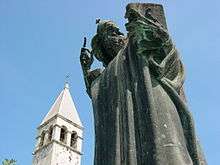
Architecture in Croatia reflects influences of bordering nations. Austrian and Hungarian influence is visible in public spaces and buildings in the north and in the central regions, architecture found along coasts of Dalmatia and Istria exhibits Venetian influence.[114] Large squares named after culture heroes, well-groomed parks, and pedestrian-only zones, are features of these orderly towns and cities, especially where large scale Baroque urban planning took place, for instance in Varaždin and Karlovac.[115] Subsequent influence of the Art Nouveau was reflected in contemporary architecture.[116] Along the coast, the architecture is Mediterranean with a strong Venetian and Renaissance influence in major urban areas exemplified in works of Giorgio da Sebenico and Niccolò Fiorentino such as the Cathedral of St. James in Šibenik. The oldest preserved examples of Croatian architecture are the 9th-century churches, with the largest and the most representative among them being the Church of St. Donatus.[117][118]
Besides the architecture encompassing the oldest artworks in Croatia, there is a long history of artists in Croatia reaching to the Middle Ages. In that period the stone portal of the Trogir Cathedral was made by Radovan, representing the most important monument of Romanesque sculpture in Croatia. The Renaissance had the greatest impact on the Adriatic Sea coast since the remainder of Croatia was embroiled in the Hundred Years' Croatian–Ottoman War. With the waning of the Ottoman Empire, art flourished during the Baroque and Rococo. The 19th and the 20th centuries brought about affirmation of numerous Croatian artisans, helped by several patrons of the arts such as bishop Josip Juraj Strossmayer.[119] Croatian artists of the period achieving worldwide renown were Vlaho Bukovac and Ivan Meštrović.[117]
The Baška tablet, a stone inscribed with the Glagolitic alphabet found on the Krk island which is dated to 1100, is considered to be the oldest surviving prose in Croatian.[120] The beginning of more vigorous development of Croatian literature is marked by the Renaissance and Marko Marulić. Besides Marulić, Renaissance playwright Marin Držić, Baroque poet Ivan Gundulić, Croatian national revival poet Ivan Mažuranić, novelist, playwright and poet August Šenoa, poet and writer Antun Gustav Matoš, poet Antun Branko Šimić, expressionist and realist writer Miroslav Krleža, poet Tin Ujević and novelist and short story writer Ivo Andrić are often cited as the greatest figures in Croatian literature.[121][122]
Symbols

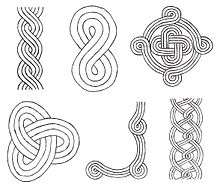
The flag of Croatia consists of a red-white-blue tricolor with the Coat of Arms of Croatia in the middle. The red-white-blue tricolor was chosen as those were the colours of Pan-Slavism, popular in the 19th century.
The coat-of-arms consists of the traditional red and white squares or grb, which simply means 'coat-of-arms'. It has been used to symbolise the Croats for centuries; some speculate that it was derived from Red and White Croatia, historic lands of the Croatian tribe but there is no generally accepted proof for this theory. The current design added the five crowning shields, which represent the historical regions from which Croatia originated. The red and white checkerboard has been a symbol of Croatian kings since at least the 10th century, ranging in number from 3×3 to 8×8, but most commonly 5×5, like the current coat. The oldest source confirming the coat-of-arms as an official symbol is a genealogy of the Habsburgs dating during 1512–18. In 1525 it was used on a votive medal. The oldest known example of the šahovnica (chessboard in Croatian) in Croatia is to be found on the wings of four falcons on a baptismal font donated by king Peter Krešimir IV of Croatia (1058–1074) to the Archbishop of Split.
Unlike in many countries, Croatian design more commonly uses symbolism from the coat of arms, rather than from the Croatian flag. This is partly due to the geometric design of the shield which makes it appropriate for use in many graphic contexts (e.g. the insignia of Croatia Airlines or the design of the shirt for the Croatia national football team), and partly because neighbouring countries like Slovenia and Serbia use the same Pan-Slavic colours on their flags as Croatia. The Croatian interlace (pleter or troplet) is also a commonly used symbol which originally comes from monasteries built between the 9th and 12th century. The interlace can be seen in various emblems and is also featured in modern Croatian military ranks and Croatian police ranks insignia.
Communities
In Croatia (the nation state), 3.9 million people identify themselves as Croats, and constitute about 90.4% of the population. Another 553,000 live in Bosnia and Herzegovina, where they are one of the three constituent ethnic groups, predominantly living in Western Herzegovina, central Bosnia and Posavina. The minority in Serbia number about 70,000, mostly in Vojvodina,[123][124] where also vast majority of the Šokci consider themselves Croats, as well as many Bunjevci (the latter, as well as other nationalities, settled the vast, abandoned area after the Ottoman retreat; this Croat subgroup originates from the south, mostly from the region of Bačka). Smaller Croat autochthonous minorities exist in Slovenia (mainly in Primorska, Prekmurje and in the Metlika area in Dolenjska regions – 35,000 Croats), Montenegro (mostly in the Bay of Kotor – 6,800 Croats), and a regional community in Kosovo called Janjevci who nationally identify as Croats. In the 1991 census Croats consisted 19.8% of the overall population of former Yugoslavia; there were around 4.6 million Croats in the entire country.
The subgroups of Croats are commonly based on regional affiliation, like Dalmatians, Slavonians, Zagorci, Istrani etc., while outside Croatia there exist several ethnic groups : Šokci (Croatia, Serbia, Hungary), Bunjevci (Serbia, Hungary), Burgenland Croats (Austria), Molise Croats (Italy), Croats of Boka Kotorska or Bokelji (Montenegro), Raci (Hungary), Krashovans (Romania), Janjevci (Kosovo).
Autochthonous communities and minorities
- Autochthonous communities
- Croatia is the nation-state of Croats.
- In Bosnia and Herzegovina, Croats are one of three constitute ethnic groups, numbering around 553,000 people or 14.6% of population. The entity of Federation of Bosnia and Herzegovina is home to majority (495,000 or about little under 90%) of Bosnian Croats.
- In Montenegro, Bay of Kotor, Croats are a national minority, numbering 6,021 people or 0.97% of population.
- In Serbia, Croats are a national minority, numbering 57,900 people or 0.80% of population. They mostly live in the region of Vojvodina, where the Croatian language is official (along with five other languages), and the national capital city of Belgrade.
- In Slovenia, Croats are not recognized as a minority, numbering 35,642 people or 1.81% of population. They mostly live in Primorska, Prekmurje and in the Metlika area in Dolenjska regions.
- Croatian communities with minority status
- In Austria, Croats are an ethnic minority, numbering around 30,000 people in Burgenland, (Burgenland Croats), the eastern part of Austria,[125] and around 15,000 people in the capital city of Vienna.
- In the Czech Republic, Croats are a national minority, numbering 850–2,000 people, forming a portion of the 29% minority (as "Others"). They mostly live in the region of Moravia, in the villages of Jevišovka, Dobré Pole and Nový Přerov.
- In Hungary, Croats are an ethnic minority, numbering 25,730 people or 0.26% of population.[126]
- In Italy, Croats are a linguistic, and ethnic minority, numbering 23,880 people, of which 2,801 people belong to ethnic minority of Molise Croats from the region of Molise.
- In Romania, Croats are a national minority, numbering 6,786 people. They mostly live in the Caraș-Severin County, in communes of Lupac (90.7%) and Carașova (78.28%).
- In Slovakia, Croats are an ethnic and national minority, numbering around 850 people. They mostly live in the area around Bratislava, in the villages of Chorvátsky Grob, Čunovo, Devínska Nová Ves, Rusovce and Jarovce.
- Croatian minorities exist in the following regions
- In Bulgaria, exist a small Croatian community, a branch of Janjevci, Croats from Kosovo.
- In Kosovo, Croats or Janjevci (Letničani), as inhabited mostly the town of Janjevo, before 1991 numbered 8,062 people, but after the war many fled, and as of 2011 number only 270 people.
- In North Macedonia, Croats number 2.686 people or 0.1% of population, mostly living in the capital city Skopje, city Bitola and around Lake Ohrid.
Diaspora
There are currently 4–4.5 million Croats in diaspora throughout the world. The Croat diaspora was the consequence of either mostly economic or political (coercion or expulsions) reasons:
- To other European countries (Slovenia, Italy, Austria, Slovakia, Germany, Hungary), caused by the conquering of Ottoman Turks, when Croats as Roman Catholics were oppressed.
- To the Americas (largely to Canada, the United States of America, Chile, and Argentina, with smaller communities in Brazil, Peru, and Ecuador, as well as to Australia, New Zealand and South Africa) in the end of 19th and early 20th century, large numbers of Croats emigrated particularly for economic reasons.
- A further, larger wave of emigration, this time for political reasons, took place after the end of the World War II. At this time, both collaborators of the Ustaša regime and those who did not want to live under a communist regime fled the country, to the Americas and Oceania once more.
- As immigrant workers, particularly to Germany, Austria, and Switzerland in the 1960s and 1970s. In addition, some emigrants left for political reasons. This migration made it possible for communist Yugoslavia to achieve lower unemployment and at the same time the money sent home by emigrants to their families provided an enormous source of foreign exchange income.
- The last large wave of Croat emigration occurred during and after the Yugoslav Wars (1991–1995). Migrant communities already established in the Americas, Oceania, and across Europe grew as a result.
The count for diaspora is approximate because of incomplete statistical records and naturalization. Overseas, the United States contains the largest Croatian emigrant group (414,714 according to the 2010 census), mostly in Ohio, Pennsylvania, Illinois and California, with a sizable community in Alaska, followed by Australia (133,268 according to the 2016 census, with concentrations in Sydney, Melbourne and Perth) and Canada (133,965 according to the 2016 census, mainly in Southern Ontario, British Columbia and Alberta).
Various estimations put the total number of Americans and Canadians with at least some Croatian ancestry at 2 million, many of whom do not identify as such in the countries' censuses.[36][37][127][39][40][128][42][129]
Croats have also emigrated in several waves to Latin America, mostly to South America: chiefly Chile, Argentina, and Brazil; estimates of their number vary wildly, from 150,000 up to 500,000.[130][131]
There are also smaller groups of Croatian descendants in the Brazil, Ecuador, Peru, South Africa, New Zealand, Mexico, and South Korea. The most important organisations of the Croatian diaspora are the Croatian Fraternal Union, Croatian Heritage Foundation and the Croatian World Congress.
Maps
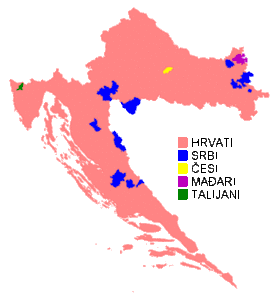 Croats in Croatia
Croats in Croatia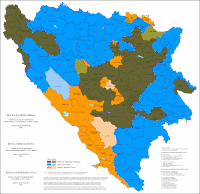 Croats in Bosnia and Herzegovina in 2013
Croats in Bosnia and Herzegovina in 2013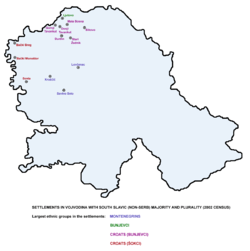 Croats in Vojvodina, Serbia
Croats in Vojvodina, Serbia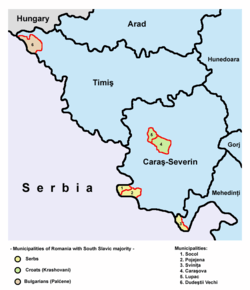 Croats in Romania
Croats in Romania
See also
- Croatia, nation-state of Croats
- Demographics of Croatia
- Timeline of Croatian history
- List of Croats
- Croatian Americans
- Croatian Argentine
- Croatians in Austria
- Croatian Australian
- Croats of Belgium
- Croats of Bosnia and Herzegovina
- Croatian Brazilian
- Croatian Canadian
- Croatian Chilean
- Croats in the Czech Republic
- Croatian Ecuadorian
- Croatians in Germany
- Croats in Hungary
- Croats of Italy
- Croats of Montenegro
- Croats in New Zealand
- Croats in North Macedonia
- Croatian Peruvian
- Croats of Romania
- Croats of Serbia
- Croats in Slovakia
- Croats of Slovenia
- Croats of Sweden
- Croats of Switzerland
- Croats in Uruguay
- Croats in Venezuela
- List of rulers of Croatia
- List of bans of Croatia
- Genetic studies on Croats
- Origin hypotheses of the Croats
- Slavs; Medieval Slav tribes; South Slavs
References
- Bellamy, Alex J. (2003). The Formation of Croatian National Identity: A Centuries-Old Dream. Manchester, England: Manchester University Press. p. 116. ISBN 978-0-71906-502-6.
- "Central Bureau of Statistics". Dzs.hr. Retrieved 26 March 2013.
- Sarajevo, juni 2016. Cenzus of Population, Households and Dwellings in Bosnia and Herzegovina, 2013 Final Results (PDF). BHAS. Archived from the original (PDF) on 24 December 2017. Retrieved 30 June 2016.
- Results American Fact Finder (US Census Bureau)
- Croatian diaspora in the USA It has been estimated that around 1.200.000 Croats and their descendants live in the USA.
- German Federal Statistical Office Archived 5 July 2006 at the Wayback Machine
- "State Office for Croats Abroad". Hrvatiizvanrh.hr. Retrieved 18 March 2015.
- "Status of Croatian immigrants and their descendants abroad". Republic of Croatia: State Office for Croats Abroad. Archived from the original on 13 February 2019. Retrieved 20 July 2013.
- Diaspora Croata El Ministerio de Relaciones Exteriores de la República de Chile evalúa que en ese país actualmente viven 380.000 personas consideradas de ser de descendencia croata, lo que es un 2,4% de la población total de Chile.
- Census 2001 "Tabelle 5: Bevölkerung nach Umgangssprache und Staatsangehörigkeit", page 60 "131,307 Croatians + 19,412 Burgenland Croats = 150,719. In the Austrian census, Burgenland Croats are separate from the main Croat group."
- "Immigration and Ethnocultural Diversity Highlight Tables". statcan.gc.ca.
- 2011 Census of Population and Housing. Australia (Excel file entitled "Basic Community Profile". Spreadsheet B08 lists population of Australia by ancestry.)
- "Croatian diaspora in Italy". Središnji državni ured za Hrvate izvan Republike Hrvatske. Retrieved 25 January 2020.
- "Попис становништва, домаћинстава и станова 2011. у Републици Србији" (PDF). Webrzs.stat.gov.rs. Retrieved 12 December 2017.
- "2006 Figures Publ.Document.88215.pdf" (PDF). p. 68. Archived from the original (PDF) on 24 June 2008. Note: Petra-P12, gives a 40,484 number. as of 2004 Archived 11 January 2012 at the Wayback Machine page 12 2.1.1. Ständige ausländische Wohnbevölkerung nach Nationalität 2001–04, gives a 44,035 number.
- "Présentation de la Croatie" (in French). Ministry of Foreign Affairs and International Development. Retrieved 28 June 2016.
- "Statistini urad RS – Popis 2002". Retrieved 18 March 2015.
- "Hrvatsko iseljeništvo u Švedskoj". Hrvatiizvanrh.hr (in Croatian). Retrieved 18 March 2015.
- "7. Facts and figures – Dalmatians – Te Ara Encyclopedia of New Zealand". Retrieved 18 March 2015.
- "Hrvatsko iseljeništvo u Novom Zelandu". Hrvatiizvanrh.hr (in Croatian). Retrieved 18 March 2015.
- Vukovich, Gabriella (2018). Mikrocenzus 2016 – 12. Nemzetiségi adatok [2016 microcensus – 12. Ethnic data] (PDF). Hungarian Central Statistical Office (in Hungarian). Budapest. ISBN 978-963-235-542-9. Retrieved 9 January 2019.
- "State Office for Croats Abroad". Hrvatiizvanrh.hr. Retrieved 18 March 2015.
- "Dom i svijet – Broj 227 – Croatia klub u Juznoj Africi". Retrieved 18 March 2015.
- "Archived copy". Archived from the original on 4 May 2011. Retrieved 20 September 2008.CS1 maint: archived copy as title (link)
- Census in Romania Archived 13 May 2007 at the Wayback Machine
- Montenegrin census page 14 Population by national or ethnic affiliation – Review for Republic of Montenegro and municipalities
- "República de Croacia". Cancillería. Retrieved 20 February 2015.
- Joshua Project. "Country – Denmark: Joshua Project". Retrieved 18 March 2015.
- "Population by immigrant category and country background". Statistics Norway. 1 January 2015. Retrieved 18 March 2015.
- "Hrvatsko iseljeništvo u Ekvadoru" (in Croatian). Retrieved 18 March 2015.
- "State Office for Croats Abroad". Hrvatiizvanrh.hr. Retrieved 18 March 2015.
- "From the lives of Croatian faithful outside Croatia". Archived from the original on 27 October 2005.
- "Croats of Czech Republic: Ethnic People Profile". czso.cz. Czech Statistical Office. Retrieved 17 April 2017.
- Marty, Martin E. (1997). Religion, Ethnicity, and Self-Identity: Nations in Turmoil. University Press of New England. ISBN 0-87451-815-6.
[...] the three ethnoreligious groups that have played the roles of the protagonists in the bloody tragedy that has unfolded in the former Yugoslavia: the Christian Orthodox Serbs, the Roman Catholic Croats, and the Muslim Slavs of Bosnia.
- "Ethnologue – South Slavic languages". ethnologue.com. Retrieved 8 February 2011.
- Farkas, Evelyn (2003). Fractured States and U.S. Foreign Policy. Iraq, Ethiopia, and Bosnia in the 1990s. Palgrave Macmillan US. p. 99.
- Paquin, Jonathan (2010). A Stability-Seeking Power: US Foreign Policy and Secessionist Conflicts. McGill-Queen's University Press. p. 68.
- Directory of Historical Organizations in the United States and Canada. American Association for State and Local History. 2002. p. 205.
- Zanger, Mark (2001). The American Ethnic Cookbook for Students. Greenwood. p. 80.
- Levinson, Ember, David, Melvin (1997). American immigrant cultures: builders of a nation. Macmillan. p. 191.
- Foreign Operations, Export Financing, and Related Programs Appropriations for 1994: Testimony of members of Congress and other interested individuals and organizations. United States. Congress. House. Committee on Appropriations. Subcommittee on Foreign Operations, Export Financing, and Related Programs. 1993. p. 690.
- National Genealogical Inquirer. Janlen Enterprises. 1979. p. 47.
- Daphne Winland (2004), "Croatian Diaspora", in Melvin Ember; Carol R. Ember; Ian Skoggard (eds.), Encyclopedia of Diasporas: Immigrant and Refugee Cultures Around the World. Volume I: Overviews and Topics; Volume II: Diaspora Communities, 2 (illustrated ed.), Springer, p. 76, ISBN 978-0-306-48321-9,
It is estimated that 4.5 million Croatians live outside Croatia (...)
- "About Us – Croatian World Coungress". 15 October 2007. Archived from the original on 15 October 2007. Retrieved 12 December 2017.
- "European Commission – Frequently asked questions on languages in Europe". europa.eu.
- "About BiH". Bhas.ba. Agency for Statistics of Bosnia and Herzegovina. Archived from the original on 11 July 2012. Retrieved 7 August 2019.
- Curta (2010, p. 323 "If anything, the reconsideration of the problem in the light of the Making of the Slavs strongly suggests that the Slavs did not have to migrate from some distant Urheimat in order to become Slovenians and Croats.")
- Dzino (2010, p. 175)
- Borri (2011, p. 215)
- Curta (2006, p. 138)
- Dzino (2010, p. 20)
- Ančić, Mladen (January 1997). "From Carolingian Official to Croatian Ruler -The Croats and the Carolingian Empire in the First Half of the Ninth Century". Hortus Artium Medievalium. 3: 7–13. doi:10.1484/J.HAM.2.305094.
- Curta (2006, pp. 141–42)
- Budak (2008, p. 223)
- Dzino (2010, p. 186)
- Wolfram (2002) Liudewit is usually considered the first Croatian prince we know of. To be true, there is no doubt that Constantine Porphyrogenitus has Dalmatia and parts of Slavonia populated by Croatians. But this author wrote more than a hundred years after the Frankish Royal annals which never mention the name of the Croatians although you will find a great many Slavic tribal names there. Therefore, if one applies the methods of an ethnogenetic interpretation, the Croatian Liudewit seems to be an anachronism.
- "Neretljani". Hrvatski obiteljski leksikon (in Croatian). Retrieved 12 December 2017.
- Fine (2005, p. 6203)
- "Wayback Machine". 25 May 2015. Archived from the original on 25 May 2015. Retrieved 12 December 2017.
- Wolfram (2002)
- Fine, John Van Antwerp (1991). The early medieval Balkans: a critical survey from the sixth to the late twelfth century. University of Michigan Press. p. 257. ISBN 978-0-472-08149-3.
- Draganović, Krunoslav (1991). Povijest Bosne i Hercegovine od najstarijih vremena do godine 1463. Hrvatsko kulturno društvo Napredak. p. 191.
- Fine, John Van Antwerp (1991). The early medieval Balkans: a critical survey from the sixth to the late twelfth century. University of Michigan Press. p. 261. ISBN 978-0-472-08149-3.
- Hrvatski leksikon (1996–1997) (in Croatian)
- Stjepan Antoljak, Pregled hrvatske povijesti, Split 1993., str. 43.
- "Kralj Tomislav". Hrvatski vojnik (in Croatian). 30 November 2018. Retrieved 27 May 2020.
- Evans, Huw M. A. (1989). The Early Mediaeval Archaeology of Croatia, A.D. 600-900. B.A.R. ISBN 978-0-86054-685-6.
- Bonifačić, Antun; Mihanovich, Clement Simon (1955). The Croatian nation in its struggle for freedom and independence: a symposium. "Croatia" Cultural Pub. Center.
- De Administrando Imperio, Byzantine Emperor Constantine VII Porphyrogenitos, 950
- Vedriš, Trpimir (2007). "Povodom novog tumačenja vijesti Konstantina VII. Porfirogeneta o snazi hrvatske vojske" [On the occasion of the new interpretation of Constantine VII Porphyrogenitus'report concerning the strength of the Croatian army]. Historijski zbornik (in Croatian). 60: 1–33. Retrieved 29 July 2020.
- Budak, Neven (2018). Hrvatska povijest od 550. do 1100 [Croatian history from 550 until 1100]. Leykam international. pp. 223–224. ISBN 978-953-340-061-7.
- Bakalov, Istorija na Bǎlgarija, "Simeon I Veliki"
- Omrčanin, Ivo (1984). Military history of Croatia. Dorrance. p. 21. ISBN 978-0-8059-2893-8. Retrieved 29 April 2012.
- Royal Anthropological Institute of Great Britain and Ireland; JSTOR (Organization) (1882). Journal of the Royal Anthropological Institute of Great Britain and Ireland. The Institute. Retrieved 29 April 2012.
- (in Croatian) PETAR KREŠIMIR IV.TRPIMIROVIĆ
- Dominik Mandić, Rasprave i prilozi iz stare hrvatske povijesti, Institute of Croatian history, Rome, 1963., page 315., 438.
- "Wayback Machine" (PDF). 13 March 2012. Archived from the original (PDF) on 13 March 2012. Retrieved 12 December 2017.
- "Demetrius, Duke of Croatia and Dalmatia". Archived from the original on 12 February 2006.
- Raukar, Tomislav (1997). Hrvatsko srednjovjekovlje: prostor, ljudi, ideje. ISBN 978-953-0-30703-2.
- "Croatia". Encyclopædia Britannica. Retrieved 18 March 2015.
- Curta, Stephenson, p. 267
- "Full text of "The southern Slav question and the Habsburg Monarchy"". Archive.org. Retrieved 18 March 2015.
- Charles W. Ingrao (2000). The Habsburg Monarchy, 1618–1815. Cambridge University Press. p. 15. ISBN 978-0-521-78505-1.
- Catholic Encyclopedia
- "Vlada Autonomne Pokrajine Vojvodine – Index". Vojvodina.gov.rs. Archived from the original on 12 February 2012. Retrieved 17 February 2012.
- Mršić, Gordan; et al. (2012). "Croatian national reference Y-STR haplotype database". Molecular Biology Reports. 39 (7): 7727–41. doi:10.1007/s11033-012-1610-3. PMID 22391654.
- "Genetic heritage of Croatians in the Southeastern European gene pool—Y chromosome analysis of the Croatian continental and Island population". AJHB. 28 (6): 837–845. 2016. doi:10.1002/ajhb.22876. PMID 27279290.
- A. Zupan; et al. (2013). "The paternal perspective of the Slovenian population and its relationship with other populations". Annals of Human Biology. 40 (6): 515–526. doi:10.3109/03014460.2013.813584. PMID 23879710.
- O.M. Utevska (2017). Генофонд українців за різними системами генетичних маркерів: походження і місце на європейському генетичному просторі [The gene pool of Ukrainians revealed by different systems of genetic markers: the origin and statement in Europe] (PhD) (in Ukrainian). National Research Center for Radiation Medicine of National Academy of Sciences of Ukraine. pp. 219–226, 302.
- Fóthi, E.; Gonzalez, A.; Fehér, T.; et al. (2020), "Genetic analysis of male Hungarian Conquerors: European and Asian paternal lineages of the conquering Hungarian tribes", Archaeological and Anthropological Sciences, 12 (1), doi:10.1007/s12520-019-00996-0
- Underhill, Peter A. (2015), "The phylogenetic and geographic structure of Y-chromosome haplogroup R1a", European Journal of Human Genetics, 23 (1): 124–131, doi:10.1038/ejhg.2014.50, PMC 4266736, PMID 24667786
- Cvjetan et al. 2004.
- P. Ralph; et al. (2013). "The Geography of Recent Genetic Ancestry across Europe". PLOS Biology. 11 (5): e105090. doi:10.1371/journal.pbio.1001555. PMC 3646727. PMID 23667324.
- Battaglia et al. 2008.
- Rootsi et al. 2004.
- Peričić et al. 2005.
- Heršak, Nikšić 2007, p. 264.
- David Dalby, Linguasphere (1999/2000, Linguasphere Observatory), pg. 445, 53-AAA-g, "Srpski+Hrvatski, Serbo-Croatian".
- Benjamin W. Fortson IV, Indo-European Language and Culture: An Introduction, 2nd ed. (2010, Blackwell), pg. 431, "Because of their mutual intelligibility, Serbian, Croatian, and Bosnian are usually thought of as constituting one language called Serbo-Croatian."
- Václav Blažek, "On the Internal Classification of Indo-European Languages: Survey", phil.muni.cz; retrieved 20 October 2010, pp. 15–16.
- Krasić, Stjepan (2009). Počelo je u Rimu: Katolička obnova i normiranje hrvatskoga jezika u XVII. stoljeću. ISBN 978-953-6316-76-2.
- Babić, Stjepan (1995). Hrvatski jučer i danas. p. 250. ISBN 978-953-160-052-1.
- Journal of Croatian studies (1986) 27–30:45
- "Croatia: Themes, Authors, Books | Yale University Library Slavic and East European Collection". Library.yale.edu. 16 November 2009. Retrieved 27 October 2010.
- Price, Glanville (1998). Encyclopedia of the languages of Europe. Oxford, UK: Blackwell Publishers Ltd. p. 425. ISBN 978-0-631-19286-2.
- Kapetanović, Amir (2005). "HRVATSKA SREDNJOVJEKOVNA LATINICA". Hrvatska Srednjovjekovna Latinica.
- Branko Fučić (September 1971). "Najstariji hrvatski glagoljski natpisi". Slovo (in Croatian). Old Church Slavonic Institute. 21.
- "Hrvoje's Missal ~ 1403–1404". Retrieved 9 March 2012.
- "VINODOLSKI ZAKON (1288)". Archived from the original on 29 April 2007. Retrieved 9 March 2012.
- "Istarski Razvod". Archived from the original on 29 April 2007. Retrieved 9 March 2012.
- "Vatikanski hrvatski molitvenik". Archived from the original on 11 October 2017. Retrieved 9 March 2012.
- "The right to use the Glagolitic language at Mass with the Roman Rite has prevailed for many centuries in all the south-western Balkan countries, and has been sanctioned by long practice and by many popes" (Dalmatia in Catholic Encyclopedia)
- Marko Japundzić. The Croatian Glagolitic Heritage, croatianhistory.net; accessed 25 November 2015.
- Clissold, Stephen; Darby, Henry Clifford (1968). A short history of Yugoslavia from early times to 1966. CUP Archive. pp. 51–52. ISBN 978-0-521-09531-0. Retrieved 30 November 2011.
- "Najljepši gradovi Sjeverne Hrvatske – Karlovac, Ozalj, Ogulin" [The Most Beautiful Cities of the Northern Croatia – Karlovac, Ozalj, Ogulin]. Jutarnji list (in Croatian). 14 August 2010. Retrieved 10 October 2011.
- Darja Radović Mahečić (2006). "Sekvenca secesije – arhitekt Lav Kalda" [Sequence of the Art Nouveau – Architect Lav Kalda] (PDF). Radovi Instituta Za Povijest Umjetnosti (in Croatian). Institute of Art History (Croatia). 30: 241–264. ISSN 0350-3437. Archived from the original (PDF) on 21 July 2011. Retrieved 10 October 2011.
- "CROATIAN ART HISTORY – OVERVIEW OF PREHISTORY". Ministry of Foreign Affairs and European Integration (Croatia). Archived from the original on 7 October 2011. Retrieved 10 October 2011.
- "Church of Saint Donat". Zadar Tourist Board. Retrieved 10 October 2011.
- Pavao Nujić (September 2011). "Josip Juraj Strossmayer – Rođeni Osječanin" [Josip Juraj Strossmayer – Native of Osijek]. Essehist (in Croatian). University of Osijek – Faculty of Philosophy. 2: 70–73. ISSN 1847-6236. Retrieved 10 October 2011.
- "The Baška tablet". Island of Krk Tourist Board. Retrieved 13 October 2011.
- "Hrvatska književnost u 270.000 redaka" [Croatian Literature in 270,000 Lines] (in Croatian). Miroslav Krleža Lexicographical Institute. 11 February 2011. Archived from the original on 17 December 2011. Retrieved 13 October 2011.
- Robert D. Kaplan (18 April 1993). "A Reader's Guide to the Balkans". The New York Times.
- Влада Аутономне Покрајине Војводине Archived 29 November 2014 at the Wayback Machine
- "Republicki Zavod za Statistiku – Republike Srbije". Archived from the original on 22 April 2009.
- "HKDC Geschichte – Frame". Croates.at. Archived from the original on 22 April 2008. Retrieved 21 November 2008.
- Hungarian Central Statistical Office Population by national/ethnic groups Archived 14 April 2011 at the Wayback Machine
- Directory of Historical Organizations in the United States and Canada. American Association for State and Local History. 2002. p. 205.
- Foreign Operations, Export Financing, and Related Programs Appropriations for 1994: Testimony of members of Congress and other interested individuals and organizations. United States. Congress. House. Committee on Appropriations. Subcommittee on Foreign Operations, Export Financing, and Related Programs. 1993. p. 690.
- "HIA – iseljenici". Hia.com.hr. Archived from the original on 4 March 2007. Retrieved 18 March 2015.
- Većeslav Holjevac. "In his book Hrvati izvan domovine estimates the number of Croatian emigrants in South America at 180,000 in 1932". Croatian Heritage Foundation. Archived from the original on 11 March 2007.
- "The Croatian Emigrant Adresary places the total number of Croats in South America as high as 500,000". Croatian Emigrant Adresary. Archived from the original on 4 March 2007.
Sources
- Dzino, Danijel (2010), Becoming Slav, Becoming Croat. Identity transformations in post-Roman and Early Medieval Dalmatia, Brill
- Curta, Florin (2001). The Making of the Slavs: History and Archaeology of the Lower Danube Region, c. 500–700. Cambridge: Cambridge University Press. ISBN 9781139428880.CS1 maint: ref=harv (link)
- Curta, Florin (2006). Southeastern Europe in the Middle Ages, 500–1250. Cambridge: Cambridge University Press. ISBN 9780521815390.CS1 maint: ref=harv (link)
- Curta, Florin (2010), "The early Slavs in the northern and eastern Adriatic region. A critical approach", Archeologia Medievale, 37
- Wolfram, Herwig (2002), "Slavic Princes in the Carolingian Marches of Bavaria", Hortus Artium Medievalium, 8: 205–208, doi:10.1484/J.HAM.2.305235
- I. H. Garipzanov; P. Geary; P. Urbanczyk, eds. (2008), "Identities in Early Medieval Dalmatia (Seventh–Eleventh Centuries)", Franks, Northmen, and Slavs Identities and State Formation in Early Medieval Europe, Brepols
- Borri, Francesco (2011), "White Croatia and the arrival of the Croats: an interpretation of Constantine Porphyrogenitus on the oldest Dalmatian history", Early Medieval Europe, 19 (2): 204–231, doi:10.1111/j.1468-0254.2011.00318.x
- L. Barać; et al. (2003). "Y chromosomal heritage of Croatian population and its island isolates" (PDF). European Journal of Human Genetics. 11 (7): 535–542. doi:10.1038/sj.ejhg.5200992. PMID 12825075.
- S. Rootsi; et al. (2004). "Phylogeography of Y-Chromosome Haplogroup I Reveals Distinct Domains of Prehistoric Gene Flow in Europe" (PDF). American Journal of Human Genetics. 75 (1): 128–137. doi:10.1086/422196. PMC 1181996. PMID 15162323.
- M. Peričić; et al. (2005). "High-resolution phylogenetic analysis of southeastern Europe traces major episodes of paternal gene flow among Slavic populations". Molecular Biology and Evolution. 22 (10): 1964–75. doi:10.1093/molbev/msi185. PMID 15944443.
- V. Battaglia; et al. (2008). "Y-chromosomal evidence of the cultural diffusion of agriculture in southeast Europe". European Journal of Human Genetics. 17 (6): 820–830. doi:10.1038/ejhg.2008.249. PMC 2947100. PMID 19107149.
- S. Cvjetan; et al. (2004). "Frequencies of mtDNA Haplogroups in Southeastern Europe-Croatians, Bosnians and Herzegovinians, Serbians, Macedonians and Macedonian Romani". Collegium Antropologicum. 28 (1).
- Heršak, Emil; Nikšić, Boris (2007), "Hrvatska etnogeneza: pregled komponentnih etapa i interpretacija (s naglaskom na euroazijske/nomadske sadržaje)" [Croatian Ethnogenesis: A Review of Component Stages and Interpretations (with Emphasis on Eurasian/Nomadic Elements)], Migration and Ethnic Themes (in Croatian), 23 (3)
External links
![]()
- (in Croatian) Matica hrvatska
- Review of Croatian History at Central and Eastern European Online Library
- "Croats of Bosnia and Herzegovina: History". Archived from the original on 15 June 2002.
- The Croatian nation at the beginning of the 20th century
- Famous Croats and Croatian cultural heritage
- "Hrvatska matica iseljenika". Croatian Heritage Foundation. Archived from the original on 27 April 2005.
- Croatians in Arizona
